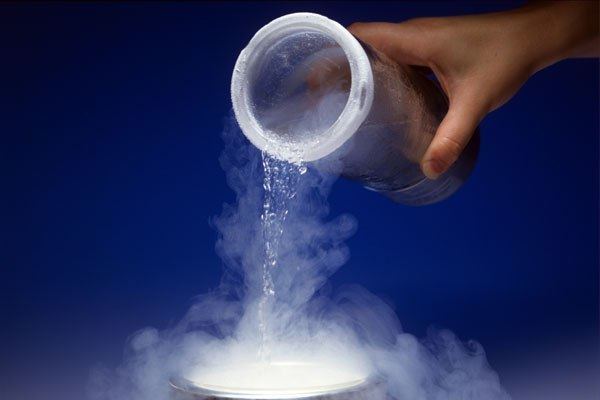 | ||
Liquid nitrogen is nitrogen in a liquid state at an extremely low temperature. It is a colorless clear liquid with a density of 0.807 g/ml at its boiling point (−195.79 °C (77 K; −320 °F)) and a dielectric constant of 1.43. Nitrogen was first liquefied at the Jagiellonian University on 15 April 1883 by Polish physicists, Zygmunt Wróblewski and Karol Olszewski. It is produced industrially by fractional distillation of liquid air. Liquid nitrogen is often referred to by the abbreviation, LN2 or "LIN" or "LN" and has the UN number 1977. Liquid nitrogen is a diatomic liquid, which means that the diatomic character of the covalent N bonding in N2 gas is retained after liquefaction.
Contents
- What does liquid nitrogen do to your face
- Uses
- Culinary use of liquid nitrogen
- Safety
- Production
- References

Liquid nitrogen is a cryogenic fluid that can cause rapid freezing on contact with living tissue. When appropriately insulated from ambient heat, liquid nitrogen can be stored and transported, for example in vacuum flasks. The temperature is held constant at 77 K by slow boiling of the liquid, resulting in the evolution of nitrogen gas. Depending on the size and design, the holding time of vacuum flasks (Dewars) ranges from a few hours to a few weeks. The development of pressurised super-insulated vacuum vessels has enabled liquefied nitrogen to be stored and transported over longer time periods with losses reduced to 2% per day or less.
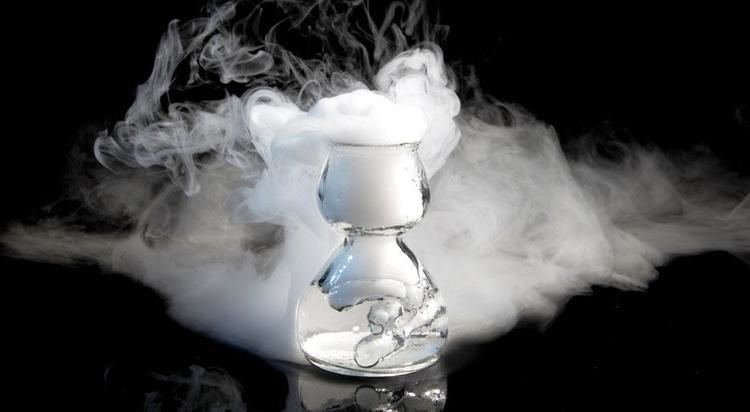
The temperature of liquid nitrogen can readily be reduced to its freezing point 63 K (−210 °C; −346 °F) by placing it in a vacuum chamber pumped by a vacuum pump. Liquid nitrogen's efficiency as a coolant is limited by the fact that it boils immediately on contact with a warmer object, enveloping the object in insulating nitrogen gas. This effect, known as the Leidenfrost effect, applies to any liquid in contact with an object significantly hotter than its boiling point. Faster cooling may be obtained by plunging an object into a slush of liquid and solid nitrogen rather than liquid nitrogen alone.

What does liquid nitrogen do to your face
Uses
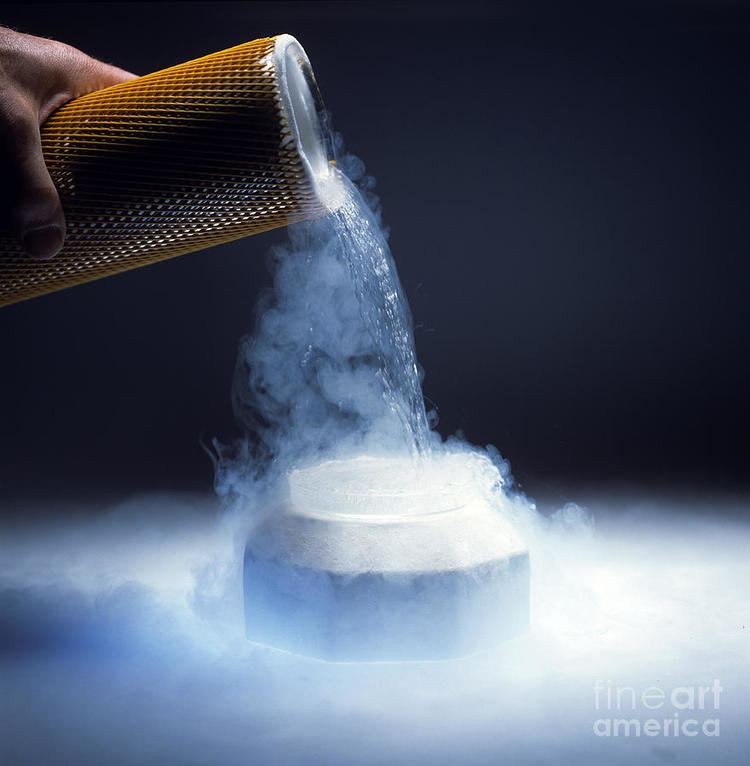
Liquid nitrogen is a compact and readily transported source of dry nitrogen gas, as it does not require pressurization. Further, its ability to maintain temperatures far below the freezing point of water makes it extremely useful in a wide range of applications, primarily as an open-cycle refrigerant, including:

Culinary use of liquid nitrogen

The culinary use of liquid nitrogen is mentioned in an 1890 recipe book titled Fancy Ices authored by Mrs. Agnes Marshall, but has been employed in more recent times by restaurants in the preparation of frozen desserts, such as ice cream, which can be created within moments at the table because of the speed at which it cools food. The rapidity of chilling also leads to the formation of smaller ice crystals, which provides the dessert with a smoother texture. The technique is employed by chef Heston Blumenthal who has used it at his restaurant, The Fat Duck to create frozen dishes such as egg and bacon ice cream. Liquid nitrogen has also become popular in the preparation of cocktails because it can be used to quickly chill glasses or freeze ingredients. It is also added to drinks to create a smoky effect, which occurs as tiny droplets of the liquid nitrogen come into contact with the surrounding air, condensing the vapour that is naturally present.
Safety
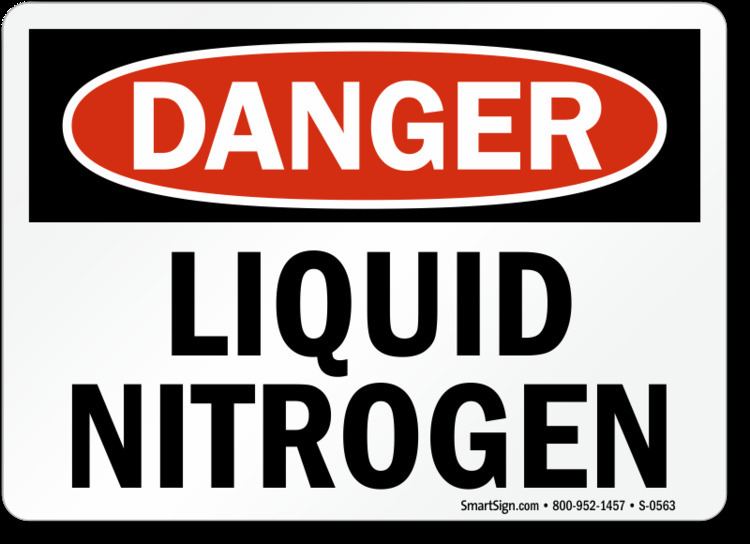
Because the liquid-to-gas expansion ratio of nitrogen is 1:694 at 20 °C (68 °F), a tremendous amount of force can be generated if liquid nitrogen is rapidly vaporized in an enclosed space. In an incident on January 12, 2006 at Texas A&M University, the pressure-relief devices of a tank of liquid nitrogen were malfunctioning and later sealed. As a result of the subsequent pressure buildup, the tank failed catastrophically. The force of the explosion was sufficient to propel the tank through the ceiling immediately above it, shatter a reinforced concrete beam immediately below it, and blow the walls of the laboratory 0.1–0.2 m off their foundations.
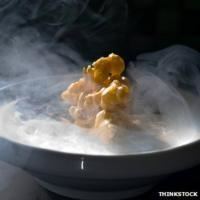
Because of its extremely low temperature, careless handling of liquid nitrogen and any objects cooled by it may result in cold burns. In that case, special gloves should be used while handling. However, a small splash or even pouring down skin will not burn immediately, because the evaporating gas thermally insulates to some extent, like touching a hot element very briefly with a wet finger. If the liquid nitrogen pools anywhere, it will burn severely.

As liquid nitrogen evaporates it reduces the oxygen concentration in the air and can act as an asphyxiant, especially in confined spaces. Nitrogen is odorless, colorless, and tasteless and may produce asphyxia without any sensation or prior warning.
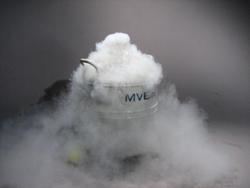
Oxygen sensors are sometimes used as a safety precaution when working with liquid nitrogen to alert workers of gas spills into a confined space.
Vessels containing liquid nitrogen can condense oxygen from air. The liquid in such a vessel becomes increasingly enriched in oxygen (boiling point 90 K; −183 °C; −298 °F) as the nitrogen evaporates, and can cause violent oxidation of organic material.
Ingestion of liquid nitrogen can cause severe internal damage. For example, in 2012, a young woman in England had her stomach removed after ingesting a cocktail made with liquid nitrogen.
Production
Liquid nitrogen is produced commercially from the cryogenic distillation of liquified air or from the liquefication of pure nitrogen derived from air using pressure swing adsorption. An air compressor is used to compress filtered air to high pressure; the high-pressure gas is cooled back to ambient temperature, and allowed to expand to a low pressure. The expanding air cools greatly (the Joule–Thomson effect), and oxygen, nitrogen, and argon are separated by further stages of expansion and distillation. Small-scale production of liquid nitrogen is easily achieved using this principle. Liquid nitrogen may be produced for direct sale, or as a byproduct of manufacture of liquid oxygen used for industrial processes such as steelmaking. Liquid-air plants producing on the order of tons per day of product started to be built in the 1930s but became very common after the Second World War; a large modern plant may produce 3000 tons/day of liquid air products.
